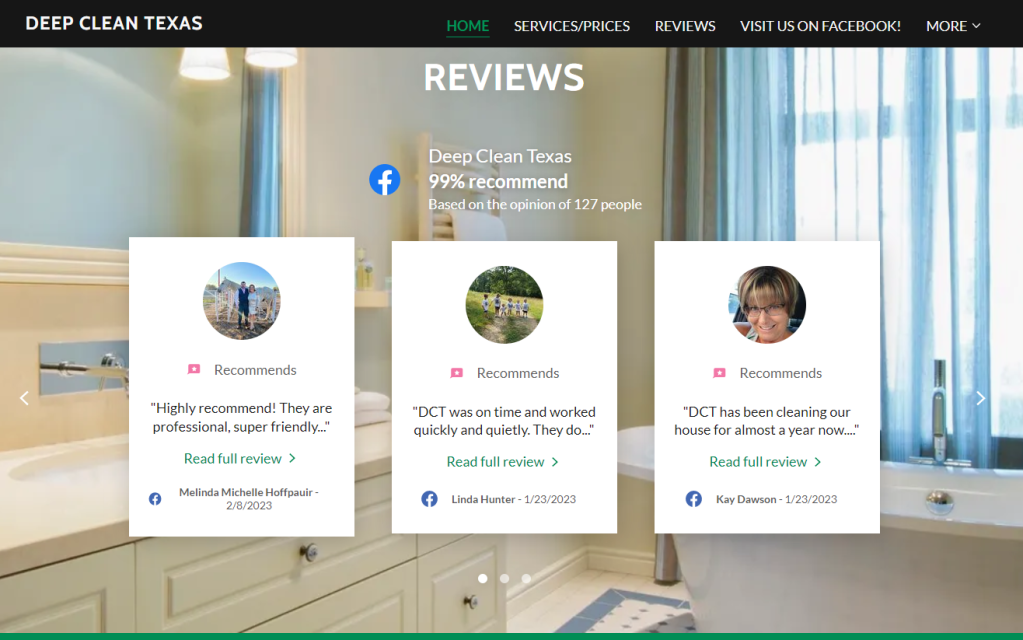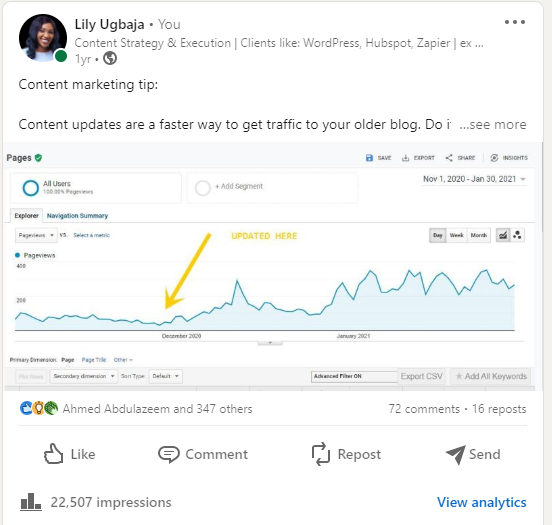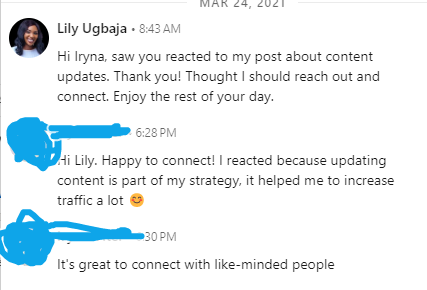One hundred and twenty-six million. That’s how often people search online for variations of the term ‘plumber’ in the US every year. And that number goes up to 296 million for the word ‘bakery’.
Can you guess how many people visit the busiest mall in the US yearly? The latest research says just 52 million.
Even if you set up shop at the mall with the most footfall in the United States, you still wouldn’t get half the number of visitors compared to internet activity for ‘plumber’ or ‘bakery’!
And it’s similar for other services too! ‘Lawyer’ gets 149 million searches and ‘restaurant’ gets a whopping 3 billion yearly US searches.
Whether you run a restaurant, offer coaching, or bookkeeping services, imagine if you showed up first when that many people search for your services online.

Here’s how to capitalize on changing buying habits to reach a wider, high-paying audience — and at a fraction of the costs of building rent and maintenance.
In this article:
- 1. Define your offer and ideal buyer
- 2. Confirm the market for your offer
- 3. Define why people should buy from you (aka your value proposition)
- 4. Create and optimize your website for traffic and conversions
- 5. Market your services on search engines, social media, and in communities
- 6. Find clients on service-specific platforms
- General Creative and Professional Services
- Teaching and Tutoring Services
- Writing Services
- Design and Development Services
- Artistic Services
- Photography Services
- Coaching and Consulting Services
- Beauty and Personal Wellness Services
- Translation and Localization Services
- Pet Care Services
- Home Repair and Contracting Services
- 7. Overdeliver to prompt referrals
- Selling services online is the future, start today!
- Frequently Asked Questions about selling services online
1. Define your offer and ideal buyer
You know when one friend talks about the treatment they got at a specific salon, and suddenly everyone only does their hair there now? That’s herd buying.
People with similar interests and demographics often hang out together. So when you can get one person to buy and love your service, word-of-mouth spreads fast to their peers.
For example, I position my content strategy service for Series A brands and smaller businesses. Since they’re often members of the same communities, I easily get referrals from my clients in their communities.
Before you even start creating a website or listing your business on social media, start by defining what you offer and to whom.
A cheatsheet to follow is “I offer ‘X’ to ‘Y’”. Where ‘X’ is the service you offer, and ‘Y’ is
- either the most profitable segment of your market
- the segment your offer would make the most sense to
- or the segment you enjoy working with the most.
Here are some examples for a photography business.
- I offer photography services to couples about to wed.
- I offer photography services to parents of newborns.
- I offer photography services to professionals looking for a headshot.
Start with a single segment of your market so that marketing is easier, and you reach profitability faster.
2. Confirm the market for your offer
The 2nd most common reason why businesses fail is a lack of market need. That’s why you should research and validate the demand for your services before you invest too much time or resources.
The fastest way to confirm the market for your service is through keyword research.
Use a keyword research tool like Semrush (you get 10 free searches per day) to search for your service.
Here’s what that looks like for the service keyword ‘Bookkeeper’. 22,000 people search for the term monthly, and 785,600 people search for variations of it.

I wouldn’t pay too much attention to the number of searches itself though. As long as it shows some search volume and isn’t trending downwards, you should be good.
This brings us to our next tip! Use search trends to confirm that demand for your service is trending upwards — or at least holding steady.
Add your service keyword to the search bar in Google Search Trends and click ‘enter’. You’ll see a chart that looks like this.

Finally, look up other businesses selling similar services as you want to sell online.
You could start with a Google search for “top [your service]” to find competitors. Then check out their:
- Number of followers and engagement on social media — high following and engagement is good!
- Number of reviews (you can search “ [competitor] reviews on Google) — if around 44% of people post reviews of services they bought online, reviews are a good indicator of buying activity in your space.
3. Define why people should buy from you (aka your value proposition)
The third most common reason why businesses fail is competition. There’s always another service provider who’s charging less or offering more.
But it’s not always realistic to charge less or offer more — especially when you’re just getting started and resources are tight.
And even if you could reduce your prices, or increase your deliverables, there’s still no guarantee that more people will hire you based on cost or deliverables alone.
To stand out from your competitors and win more customers, you need a unique value proposition (UVP).
UVP: A clear statement which outlines unique, important benefits customers can only get through working with you.
It’s a fancy way of saying, “what makes your offer different (and better) from all the other options out there?” Defining this can help you attract people who are more aligned with your personal values.
To define your UVP, list:
- Your customers’ pain points, stories, and goals. (Pain points to understand the jobs to be done, stories to be able to show empathy, and goals to understand big-picture objectives.)
- How your service caters to those pain points, aligns with their stories, and fulfills those goals.
- Where your competitors fall short on those three fronts (or what they’re doing wrong).
The intersection of those three things is your UVP.

4. Create and optimize your website for traffic and conversions
Like you’d need a brick-and-mortar store in the physical world, you need an online storefront to sell online!
Now you may be tempted to build your storefront on third-party platforms like Fiverr, or Facebook Marketplace, but a responsive, SEO-friendly (we’ll get to that in a bit) website optimized for conversions is the way to go. Here are just three (of the many) reasons:
- Control: While platforms like Fiverr can be great for getting started, there’s always a risk that they could disappear, or ban your account without warning. With your own website, you are not at the mercy of platform policies and rules that could result in a loss of all the work you put into building up your online presence and customer base.
- Ownership: Platforms like Fiverr own your customer data, including buying data, and contact details. If you had to leave the platform, you’d essentially start from scratch. A website gives you ownership over all of those.
- Differentiation: Your pricing on marketplaces like Fiverr will greatly depend on the pricing of other service providers there (and they have a reputation for being notoriously low). It’s a marketplace, after all, and there’s always another service provider next door. In contrast, your own website puts you in a league of your own, where you can tailor the brand experience to attract only premium clients.
“…freelance sites were extremely competitive with a lot of low-priced providers. This attracted a lot of clients who were mainly hiring based on price alone… At this point, I moved away from the freelancing sites and only listed my services on my own WordPress website. It allowed me to attract more premium clients who were looking for quality work, and were happy to pay a fair amount for it.” says Ryan Turner of Ecommerce Intelligence.
“The business now makes $15,000 – $20,000 monthly while I work on it part-time and still have a few days a week to spend working on another passion project business I’m starting,” Ryan says.
To build your service website, follow these steps:
1. Define the goal for your website
There are different types of websites, eCommerce sites, portfolio sites, business sites etc.. The website you need to create will depend on your goal.
If your service can be delivered online, your goal may be either to sell directly online (eCommerce, or portfolio site), or have people hire you for on-premise service (or both!).
If you can only deliver on-premise, however, your goal would be to get people to either come into your building or hire you to come to them.
2. Look for design and copy inspiration
It can be helpful to look at other sites for design and copy inspiration for several reasons:
- To take note of elements you liked, and didn’t like, and understand what works and what doesn’t for look and feel in your niche.
- To observe the types of pages, images, and content services in your industry use on their website.
- To find ways to differentiate yourself without straying too far from the industry standard.
Start with a Google search for websites in your niche. For example, you could search for ‘hire a bookkeeper’. Look through the top websites that come up in the search results.
3. Choose your website platform
For many service providers, it’s going to be too technical and expensive to build a website from scratch. That’s where platforms like WordPress.com, Wix, and Squarespace come in — they provide website ‘frames’ that you can customize to meet your needs.
With so many options available, it can be difficult to know where to start. Here are some factors to consider when choosing:
- Ease of Use: Choose a platform with a user-friendly interface and step-by-step guidance.
- Customization Options: If you want your website to have a unique look and feel, look for a platform that offers customization options, such as the ability to add your own branding and imagery.
- Integrations: If you’re using other tools and services, like an email marketing platform or a payment gateway, look for a platform that integrates with these tools. This will make it easier for you to manage your website and your business.
- Budget: Some website platforms are free, while others require a monthly or yearly subscription. Decide on a budget that you are comfortable with and look for platforms that fall within your price range.
- Scalability: You want a platform with plans that allow one-click scaling.
- Security: Look for a platform that offers robust security features, such as SSL encryption and regular software updates, to protect your website and your customers’ data.
With pricing, customization, integrations, support, and scalability, for example, WordPress.com beats competitors like Wix and Squarespace.

Your website platform should also have these functionalities, or allow plugins that enable them:
- Booking (see Booking Plugins)
- Payments (see Finance and Payments Plugins)
- Social sharing (see Social Media Plugins)
- Email marketing (see Email Plugins )
- eCommerce (see WooCommerce)
4. Buy a domain name
Your domain name acts as a unique address where people can find you online. Use one that’s short, easy to spell and type, brandable, and, if possible, includes your service keyword.
For example, if you’re a bookkeeper, you could use something like ‘lilybookkeeping.com’ or ‘bookkeepersden.com’…
Or you could just use your business name if you have one.
You can buy a domain name from services like namecheap.com, or get one free for the first year when you use WordPress.com to build your business site.

5. Choose a theme
With platforms like WordPress.com, themes are the foundation for the look and feel of your website. Your platform may have a robust theme library, allow you to import themes from third-party sites, or don’t allow external themes at all.
Look for themes that match your desired style and offer the functionality you need, such as a portfolio section or e-commerce capabilities.
Tip! WordPress.com has over 30 business themes, including free ones to choose from. And over 200 themes in total! What? That’s still not enough? With a plugin-enabled plan, you can choose from more than 5,000 themes offered in the WordPress repository or install any custom theme of your choice.

When choosing a theme, look for the following:
- A mobile-responsive theme that adjusts to different screen sizes and looks good on any device.
- An uncluttered theme that has a clean and professional design, with clear typography and an easy-to-use layout.
- A theme that allows you to use the features you need, such as a contact form, image gallery, or blog section.
- A theme that allows you to customize colors, fonts, and layouts.
6. Sketch your website navigation
Which pages will your website have and what would website navigation look like?
Most service businesses will only need a home page, an about page, a services page, a portfolio page, and a contact page (5 pages).
But if you sell more than one service, you may need several pages, one for each service. You may also need a ‘blog’ page if you choose to blog for marketing.
7. Add your website copy and launch
Your website copy is your chance to tell your story, explain what sets you apart from your competition, and convince potential customers to choose your business.
Here are some tips for writing effective website copy:
Start with your UVP: Before you start writing, think about the message you want to convey. What do you want to tell your customers about your business? What sets you apart from your competition? Having a clear message in mind will help you write focused, persuasive copy.
My UVP, for example, is ‘content strategy based on real data (not fictitious personas)’, so I call that out everywhere on my website, starting from the landing page.

Keep it simple: Your website copy should be easy to read and understand. Use short sentences, and clear language, and avoid technical terms or industry jargon.
Focus on the benefits: When writing about your services, focus on the transformation you provide, rather than just the deliverables. Explain how your services can make your customers’ lives easier, more convenient, or more enjoyable.
For example, Deep Clean Texas focuses on how their cleaning service frees up time for customers to focus on more important things.

Paint a picture: People are more likely to remember and connect with a story than with a list of facts. Consider weaving a story into your website copy to help engage your audience and create an emotional connection.
I love how Chima Mmeje of Zenith Copy does this succinctly here.

Add social proof: If you have existing customers, consider collecting testimonials and reviews from them to sprinkle all through your website.
Here’s an example from Deep Clean Texas’ website.

Use clear calls to action: Your website copy should encourage customers to take action, whether it’s making a purchase, signing up for a newsletter, or contacting you for more information. Make sure your calls to action are clear and easy to understand.
Some examples to use include:
- Contact us now
- Book a discovery call
- Book a free session
If you need guidance to add your copy to specific pages, see our guide to getting started on WordPress.com.

5. Market your services on search engines, social media, and in communities
After you’ve set up your website, you need to get people to look at it — so they can evaluate and buy your services.
Here are some things you can do:
Register your profile on Google
The fastest impactful thing you can do is to register for a Google Business Profile, especially if you need to be on-site to deliver your service. It will help you show up for people close to your business area when they search on Google.
Go to the Google Business Profile page and click ‘Manage Now’, then follow the instructions to set up your account.

But don’t stop at setting up your profile, the real magic is in collecting reviews. “Even though it feels awkward, I ask people to leave me positive Google reviews,” says Brittany Wren, Founder of Stringray Writing.
The more positive reviews you have, the higher you can rank in local business profiles. For example, when we met my daughter’s physiotherapist, his business wasn’t even listed, and another physiotherapist dominated local search results.
After setting up his profile and encouraging him to ask for reviews, his business now outranks others for local search and he’s gotten many clients from it!

Start a blog educating potential customers
A blog allows you to create content that provides expert education to your target audience. This can help you build relationships, establish your expertise, and position yourself as a trusted resource in your industry.
Regularly creating and publishing blog content can help improve your search engine ranking, making it easier for potential customers to find you. And, you can generate some side income from your blog too!
“Starting the blog and publishing content first was definitely the best thing I ever did. Not only do I receive inbound leads, but I also get to prove my value and build trust with my potential clients very quickly” says Luciano Viterale, Copywriter.
If you have a WordPress.com site, adding a blog on top of it is easy since our platform supports blogging. Here’s how to blog on WordPress.com.
Build relationships and educate on social media
Social media is the second most popular way for people (42%) to research before they buy.
I’m a six-figure service provider who doesn’t run a blog or have my business listed on Google Business, but I’ve never had a dry spell in 2+ years.
All of my clients have come from educating my target audience on social media, and building relationships with peers and potential clients. Like this one.

Side Note: You’ll notice I point the client to my website in the screenshot. That’s because even though I rely on social media for marketing, I realize that I need a platform where people can still find me if I lose my social media accounts.
Here’s how you can use social media to reach those people, and build relationships that grow your business:
Choose the right platforms: Not all social media platforms are created equal. Choose the platforms where your target audience is most active and start building your presence there.
Create rounded content: Most people share only educational content, and that’s a great start. But if you want to build trust and authority fast, you need to share results and processes as well. One of my best-converting posts is this one where I shared a result chart. For a cleaning business, that may look like before/after photos of a cleaned apartment (shared with permission, of course 😁).

Engage with your audience: Respond to comments and messages. Ask for feedback, and participate in relevant conversations. I take it a step further and message people casually when they engage with my posts. But I’m not selling anything at that point. Here’s an example. This message eventually led to a business deal.

Be consistent: To be effective on social media, you need to be consistent. Develop a schedule for posting content, responding to comments, and engaging with your audience, and try to stick to it. I try to post at least once a week, for example.
Here are more tips to get traffic to your service website.
6. Find clients on service-specific platforms
Aside from search and social media, you can find clients on other platforms specific to your market or industry.
Here are some depending on your service:
General Creative and Professional Services
Teaching and Tutoring Services
Writing Services
Design and Development Services
Artistic Services
Photography Services
Coaching and Consulting Services
Beauty and Personal Wellness Services
Translation and Localization Services
Pet Care Services
Home Repair and Contracting Services
7. Overdeliver to prompt referrals
“Every single current customer I have was referred to me by someone I’ve worked with in the past or someone who knows me and knows I deliver good work. When you’re just starting out, people need to be able to trust you,” says Brittany.
When you get clients, do good work, be reliable and communicative so your customers will want to share about their experience with you.
If you want to take it a step further, tools, communication rules, and automation help you ensure you’re providing the best possible experience for your customers:
- Use a customer relationship management tool to keep track of customer interactions and manage your relationships with them.
- Automated email and messaging tools can help you respond to customer inquiries and follow up with them quickly and efficiently.
- Project management tools help you keep track of tasks, deadlines, and progress on projects. This can help you ensure that you’re delivering your services on time and to the highest standards.
- Ask questions to make sure you understand customer needs and expectations, and communicate your processes and expectations to them clearly and effectively.
- Follow up with customers regularly to ensure that their needs are being met and that they’re satisfied with your services. This can help you build trust and establish a long-term relationship with your customers.
- Automate routine tasks such as sending follow-up emails, updating customer information, and sending progress updates, to save time and ensure consistency.
There’s so much you can do!
Selling services online is the future, start today!
The internet presents massive reach for any service provider, and that reach is only going to grow. Whether you’re an established business or an individual just starting out, there has never been a better time to get started.
But you need a solid strategy too.
It’s also a more crowded space online so branding, positioning, and a stellar customer experience are important to stand out and gain loyalty.
With the right tools, resources, and strategy, you can build an online presence, reach potential customers, and start generating income from your services.
Want to test run this selling services online thing first? Take advantage of a free WordPress.com site today.
Frequently Asked Questions about selling services online
What does it mean to sell services online?
Selling services online refers to the process of offering professional services over the internet, typically through a website or marketplace platform.
What kinds of services can you sell online?
You can sell creative services like writing, photography, design, business services like consulting, physical services like styling, landscaping, and lots more.
What is the best way to sell your services?
The best way to sell your services is to start by identifying your target audience, then creating a website, and engaging in marketing services to build an online presence for your business.
Want more tips? Get new post notifications emailed to you.

